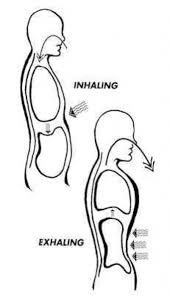 Breathing Mechanism
Breathing Mechanism Since this is being written for the general public as well as professionals there will be some over simplification and some complexity to the articles. Please feel comfortable to submit questions and comments for both clarification and answers to your specific issues.
When teaching Muscle Release Therapy, MRTh® or Fundamental Movement Pilates (SM) the first item on the agenda is breathing. In therapy we look for any of the key components not functioning and in movement we emphasize the need to breathe properly. The body has a series of diaphragms or bellows that need to expand and draw in air and contract to expel air. In therapy it is important because without the proper breathing mechanisms working the tension on the skeleton will always be compromised. In movement it is important that anytime an individual exerts energy that they are in the process of exhaling.
There are two items being served here, the first is we need to have oxygen in the blood for its nourishment as well as the tissue it services. Secondly, it sets all of the other components of movement in motion. The primary areas or diaphragms that the therapist should be assessing is the neck, mid-abdominal region and the pelvic floor. These are the three primary bellows that will draw in and expel air. An important note here is that not only do these diaphragms function in the breathing mode but on exertion will protect the neck and low back as it helps to stabilize.
For the therapist this would be the Scalene muscles (neck), mid abdominal diaphragm and oblique muscles (rib cage), the Psoas major and minor (hip flexor and back) and the Adductor Magnus (inner thigh) for proper movement of the Pelvis.
The neck acts as a diaphragm as on inhalation we shorten the muscles and exhalation we elongate the muscles. How does exhaling protect the neck, its primary goal is to decompress the vertebrae and take pressure off of the disc material and nerves.
The belly diaphragm (see picture above) allows the lungs to expand as it draws in air and contracts to expel air. Notice though how the abdomen (stomach) region compresses during the exhalation process, this is to protect and decompress the low back so that pressure is taken off of the discs.
The Pelvis diaphragm is the control center as it places the main support structure in the proper position to absorb the change in tension when we exert energy.
When we inhale we should feel a normal tightness in both the neck and pelvic region and expansion of our belly. On the exhale, it will be just the opposite. These subtle movements set the base for all movement within the body. It is accomplished at a subconscious level and in times of mental or physical stress periods we often interrupt this natural pattern and hold our breath. It is at these times we need to consciously remember to breathe.
Whether we are walking, running, biking, weight training, Pilates, Yoga, or some other form of exercise we need to also consciously exercise our breathing patterns. The easiest way to do this is to keep the jaw relaxed and not tighten or compress it. What this accomplishes is forced breathing patterns and will keep us in a normal breathing rhythm. If we need to clench our jaw, then we are doing something that is compromising the structure itself. All this will do is force the brain to use a part of the body it shouldn't be.
The blog will continue to incorporate more on breathing during movement as we continue to explore other anatomy parts of the body. So until next time, practice your breathing, inhale pulling up through your feet all the way to your head and you will ensure that all the necessary parts will receive the oxygen it needs to function.
If you are looking for that quiet spot to practice your breathing, remember our new Spirit Space is open for you, call and reserve your time at 216-364-0152, there is no cost for using this room, it is Marge's desire that we all find peace and solitude in it.
So with every breath we take, remember there is always a REASON TO HOPE!
Dennis
 RSS Feed
RSS Feed
